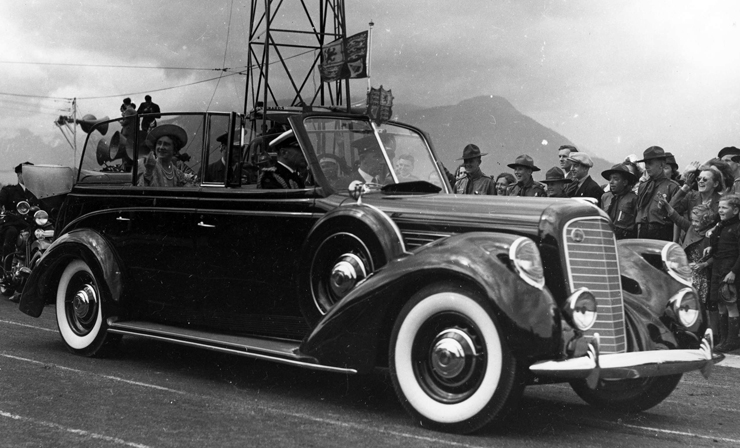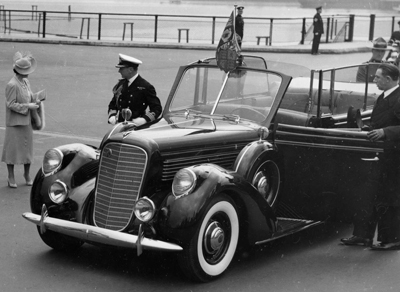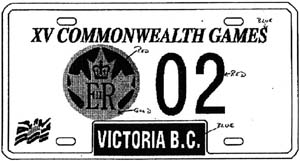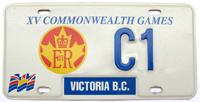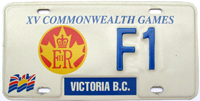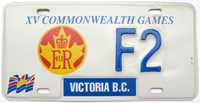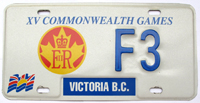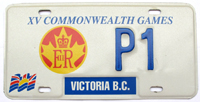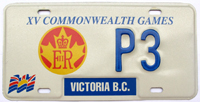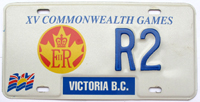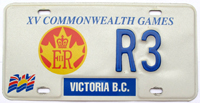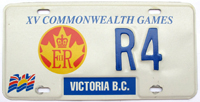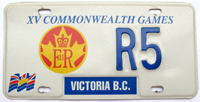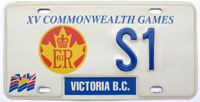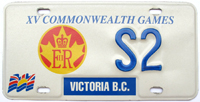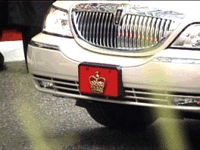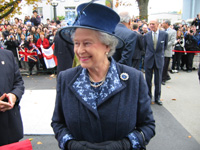|
License Plates from the Royal Visits to British Columbia |
|||||||||||||||||||||||||||||||||||||||||||||||||||||||||||||||||||||||||||||||||||||||||||||||||||||||||||||||||||||||||||||||||||||||||||||||||||||||||||||||||||||||||||||||||||||
Quick Links: |
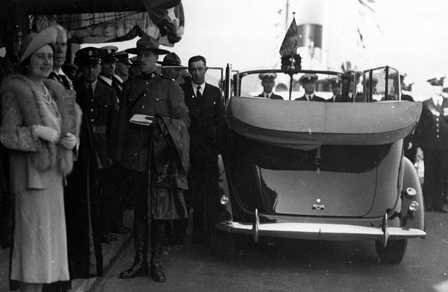 |
The Lincoln was used to transport the Royals and appears to have performed the lion's share of the chauffeuring duties in Vancouver and has resided in Ontario ever since, while the Lincoln Model K has stayed in BC and, at last report, was on display at the West Coast Railway Heritage Park in Squamish. As a nice touch - and apparently reflective of its owners connections - the Buick displays as its validly registered licence plate Antique No. 1939!
|
|
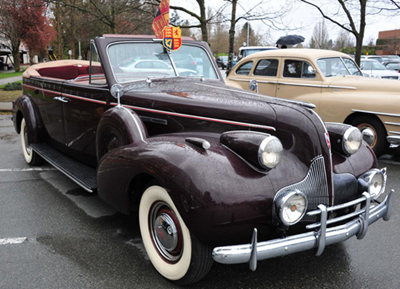 |
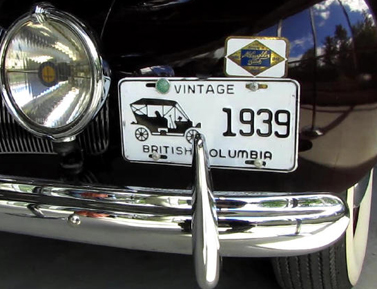 |
The Lincoln Model K - which is easily distinguishable from the other model by its front grill - has subsequently been used twice to transport Royals visiting the province. Once in 1986 when Prince Charles and Princess Diana came to Vancouver to open the 1986 World Exposition (Expo 86):
|
 |
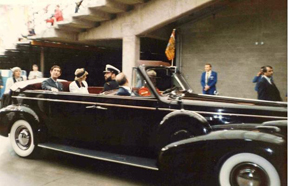 |
As the vehicle was participating in the Vintage International Antique Auto Show being staged at BC Place Stadium during Expo, it did display one of the souvenir licence plates - No. 191 - on the back of the vehicle (Click Here to read more about these plates). According to the guidebook published in relation to the Antique Auto Show, the owner of the vehicle at that time was Vern Bethel of Vancouver.
|
The other time that the Lincoln Model K has been used to carry Royalty was when the Queen and Prince Phillip came to Victoria to open and close the 15th Commonwealth Games in August of 1994 (see further down this page for more information on this visit):
|
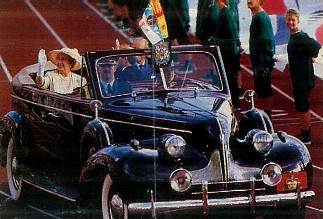 |
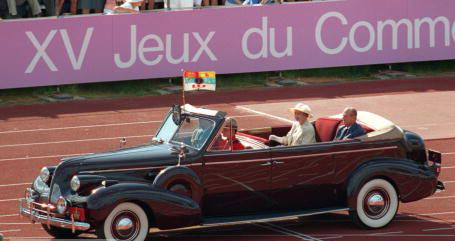 |
| 1951 Royal Visit |
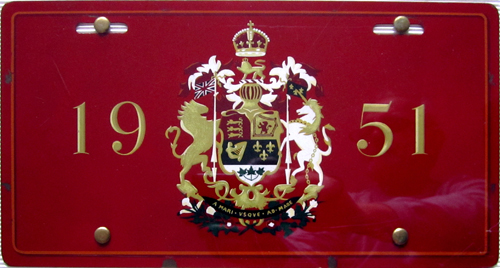 |
Twelve years later, and with the war concluded, Princess Elizabeth and the Duke of Edinburgh were sent on a tour of Canada in the fall of 1951 essentially to thank Canadians for the military support they had provided the “mother country.”
|
A coast-to-coast tour of the country, the Princess and Duke would arrive in Vancouver on October 20th where, amongst other things, she would plant an oak sapling at Queen Elizabeth Park (named for her mother). |
Although the tour would principally be conducted by rail, for short distances within cities such as Vancouver and Victoria, automobiles would be utilized. |
As the story goes, a GM dealership in Toronto had been asked to prepare six cars to “dignitary standards of class and security” to be used as part of the tour, two of which would stay in the Toronto area, while the others would be shared between the Maritime and Western Provinces. |
 |
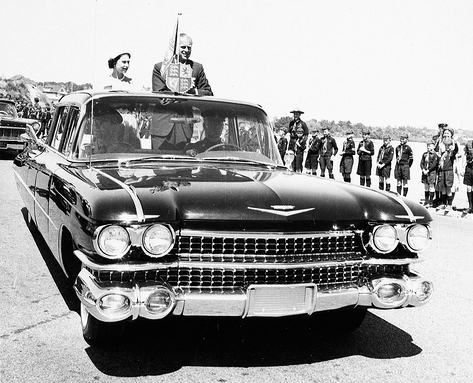 |
At the conclusion of the royal visit, the cars were to be sent back to the General Motors plant in Detroit, however, the owner of the dealership, a Mr. McDougall, envisioned the day he would be giving his daughter away in marriage and secretly kept a black convertible Cadillac that had been used by the Princess – as well as the special license plates that accompanied it. |
In 1989, the plate would be acquired by local collector Pierre Delacote who happened to work with the grandson of Mr. McDougall at the Teahouse Restaurant in Stanley Park. While the convertible Cadillac was long gone, the family had kept the special license plate as a souvenir for almost forty years. |
As can be seen in the picture above, there are scratches to the paint at the side and bottom of the plate. As the tour took place in the period just prior to the standardization of license plate dimensions in North America, the royal license plate measures 12” by 6.5” instead of the emerging standard of 12” by 6” and, therefore, did not fit the bolt holes on the car. |
Subsequently, a photo was found showing one of the cars chauffeuring the Princess and Duke at a rally in Toronto with little white clips at the side and bottom of the plate to hold it in place. |
Less than four months after this tout, Princess Elizabeth would become Queen in February of 1952, following the death of her father, King George VI. |
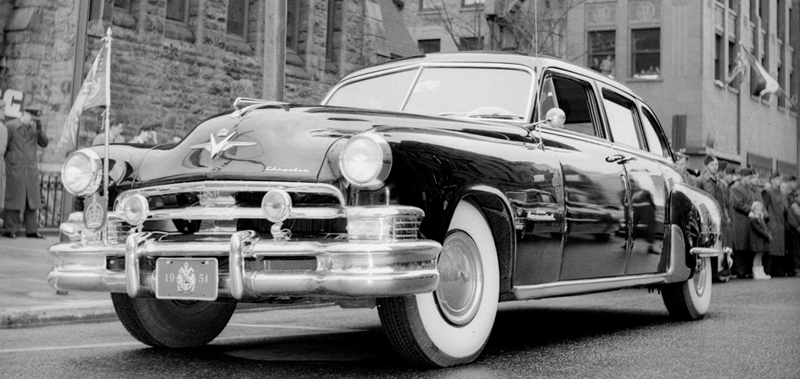 |
| 1987 Royal Visit - Commonwealth Heads of Government Meeting (CHOGM) | ||
What
the heck is the Commonwealth Heads of Government Meeting
you may be asking? |
||
Well
my friends, that was my first response too, and after some
investigating it would seem that the CHOGM is a biennial
summit involving the heads of government from all Commonwealth
nations and generally involves an appearance from Her Most
Excellent Majesty, the Queen (as head of the Commonwealth).
For those history buffs out there, it might sound more familiar
as the old Imperial Conferences that were held during the
first half of the 20th century. |
||
Canada has hosted two CHOGM's with the first being in Ottawa under Pierre Trudeau's Prime Ministership in 1973, and the second meeting in Vancouver under Brian Mulroney's Prime Ministership in 1987. |
||
In
recognition of Her Most Excellent Majesty, the Queen, and
His Royal Highness the Duke of Edinburgh visit to British
Columbia to open the 1987 CHOGM, the Superintendent of Motor
Vehicles, Keith Jackman, authorised the issuance of "special
number plates" (deemed to be in accordance with Section
11(3) of the Motor Vehicle Act). |
||
These
plates were only to be used on vehicles forming part of
the official motorcade and that were already licensed and
insured in BC. The Superintendent also required that the
regular license plates; Certificate of Vehicle Registration;
Certificate of Insurance and Vehicle Licence; and a copy
of a letter signed by the Superintendent setting out the
validity of the plates be carried in each vehicle displaying
them. |
||
According
to Ernie MacAulay, twenty (20) pairs of plates were requested,
numbered "ROYAL 1" to "ROYAL 20" and
utilising the Ham Radio base. |
||
Originally
the Motor Vehicle Branch approved the issue with the serial
numbers in the same blue as the regular passenger plates
allegedly because it would be too difficult to produce them
with red serial numbers. However, Astrographics Limited
had already confirmed to Ernie MacAuley that they could
readily produce the "ROYAL" plates with distinctive
red serial numbers using the same colour seen on the Prorated
plates issued in 1986 (and again in 1988). Based upon this,
the MVB reversed itself and consented to the use of the
red serial numbers. |
||
|
||
Interestingly,
while it had been intended that the Queen's vehicle would
display the plate "ROYAL 1", this did not occur
as Her Majesty's limousine was provided with a gold coat
of arms on a red background (a design that would be seen
in subsequent trips). It is suspected that, for this reason,
the plate shown above ("ROYAL 1") was destroyed
by cutting it in half. |
||
At
the conclusion of the summit, the Superintendent required
that one plate from each pair be returned to his office
for distribution to senior provincial personnel and senior
personnel who worked on the Royal Visit. The remaining plates
were presented to the motorcade drivers.
|
| 1994 Royal Visit - Commonwealth Games (Victoria) | |||
With
the Queen again scheduled to visit British Columbia from
August 15-20, 1994, to open the Commonwealth Games being
held in Victoria that year, Ernie MacAuley, Superintendent
of the RCMP Security Office for the Royal Visit, queried
the Motor Vehicle Branch (MVB) about the possibility of
issuing special license plates for the occasion. |
|||
A
request, dated May 20, 1994, noted that the "ROYAL"
series was now being used on personalised plates for a limousine
company, so it would now be necessary to use an alternate
series. The initial suggestion was for a twenty plate set
to be issued from "E II R 2" through "E II
R 20" ("E II R" being the latin abbreviation
for the Queen Elizabeth II). |
|||
 |
|||
MacAuley
also recommended "that the Ham Radio blank be used
again with the letter painted rid (to complement the background
of the Queen's 'coat of arms' plate and to distinguish the
series from the regular passenger and commercial vehicle
plates). To make the plates even more distinctive, I would
suggest that 'Beautiful British Columbia' be replaced with
'XV Commonwealth Games' and 'Victoria, B.C.' be placed in
the areas reserved for validation stickers." |
|||
Subsequent
correspondence of June 23rd provided the MVB with a copy
of the badge that had been personally approved by Her Majesty
for the Canadian visit (see below). |
|||
|
|||
MacAuley
also "concluded that it would be more appropriate to
use a decal of the Visit Badge rather than attempting to
emboss 'E II R' onto a series of plates. Decals were used
in Ontario for the Papal Visit in 1984 and for an Economic
Summit with very attractive results." |
|||
A
final correspondence, dated July 28th (18 days before the
Visit), indicates a minor change to the plates by changing
the serial to an alpha-numeric type (there would be 19 sets): |
|
|
Unlike
1987, following the conclusion of the Royal Visit, the MVB
required that the special issue plates be returned with
an allowance for one plate to be retained by the RCMP for
display purposes in "E" Division Headquarters. |
||||||||||||||||||||||||||||||||||||||||||
Over
a year later, on October 30, 1995, a News Release was issued
by the Ministry of Transportation an Highways advising that
it was "making available for public sale 18 pairs"
(I wonder which pair the RCMP elected to display at HQ?)
of the Royal Visit plates. |
||||||||||||||||||||||||||||||||||||||||||
The
News Release went on to state that "public sale of
the plates will give British Columbians an opportunity to
take away a cherished memento from a very special moment
in B.C.'s history ... It also enables us [the Ministry]
to recover the cost of manufacturing them ... Collectors
and the public will be able to purchase the plates through
a process of sealed bids. Interested buyers submit their
bid forms and sending them to the B.C. Purchasing Commission
by the closing date of Jan. 30. The winners will be contacted
shortly after." |
||||||||||||||||||||||||||||||||||||||||||
When
the bidding closed, the following amounts were paid for
each set of plates: |
||||||||||||||||||||||||||||||||||||||||||
|
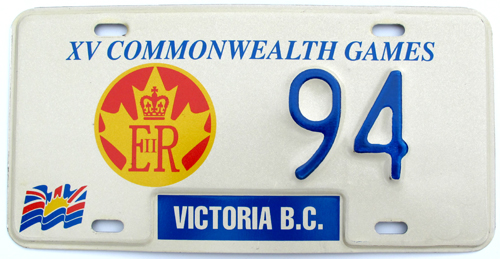 |
At left is a prototype of the 1994 Commonwealth Games license plate that was produced by Astrographic. It is one of two known examples (the other being No. 24) where a letter prefixed does not appear in the serial number. |
| 2002 Royal Visit - Golden Jubilee Tour (Canada) | ||||||
| In
2002, the Queen undertook another visit to British Columbia.
The following pictures show the license plates that were
used on her vehicles in both Victoria (at left) and Vancouver
(at right). |
||||||
|
||||||
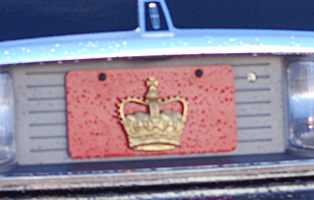 |
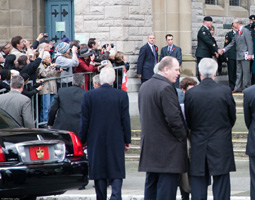 |
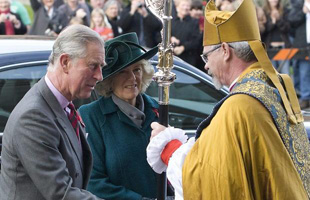 |
Prince
Charles & Camilla at Christ Church Cathedral in Victoria,
November 8, 2009 |
||
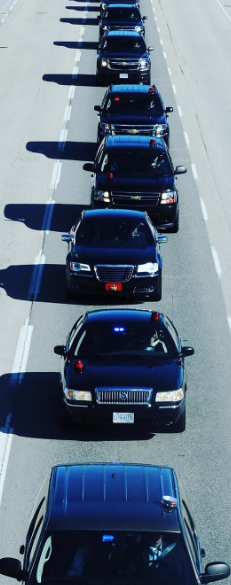 |
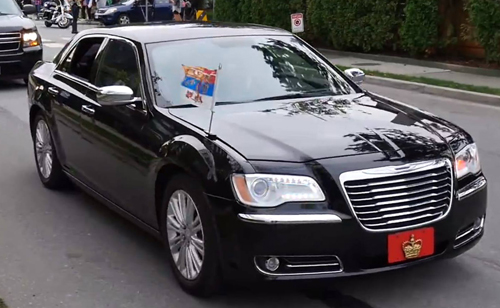 |
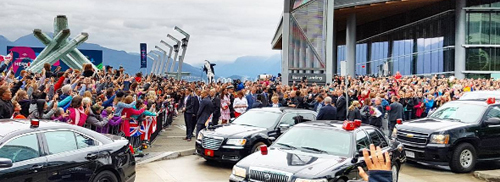 |
|
 |
 |
Interestingly, and as can be seen in the photo at left, but much better in the photo at bottom-right, the other vehicles in the official motorcade sported red identifiers on the tops of their roofs. We haven't really seen anything like this since the single letter prefixes used in the series of plates issued for the 1994 Commonwealth Games (see section above). If anyone out there knows anything about these numbers, please drop us a line. |

Yes, yes ... we will see you again sometime soon. |
Quick Links: |
Antique | APEC | BC Parks | Chauffeur Badges | Collector | Commercial Truck | Consul | Dealer | Decals | Driver's Licences | Farm | Ham Radio | Industrial Vehicle | Keytags | Lieutenant Governor | Logging | Manufacturer | Medical Doctor | Memorial Cross | Motive Fuel | Motor Carrier | Motorcycle | Movie Props | Municipal | National Defence | Off-Road Vehicle | Olympics | Passenger | Personalized | Prorated | Prototype | Public Works | Reciprocity | Repairer | Restricted | Sample | Special Agreement | Temporary Permits | Trailer | Transporter | Veteran | Miscellaneous |
© Copyright Christopher John
Garrish. All rights reserved.

